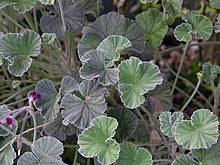Pelargonium sidoides
| Pelargonium sidoides | |
|---|---|

| |
| Scientific classification | |
| Kingdom: | Plantae |
| Clade: | Tracheophytes |
| Clade: | Angiosperms |
| Clade: | Eudicots |
| Clade: | Rosids |
| Order: | Geraniales |
| Family: | Geraniaceae |
| Genus: | Pelargonium |
| Species: | P. sidoides
|
| Binomial name | |
| Pelargonium sidoides DC. | |
Pelargonium sidoides is a plant native to South Africa, Eswatini, and Lesotho. Its common names include African geranium and South African geranium. The current conservation status is Least concern.[1]
Description
African geranium forms a basal rosette of
trichomes on long petioles.[2] Its flowers have five dark red to nearly black petals, two of which are sometimes fused. It is often found in flower nearly year-round. It prefers to grow in grasslands with rocky soils. It can be difficult to distinguish from Pelargonium reniforme
which grows in a similar area, but tends to have more kidney-shaped leaves.
Uses
In cultivation in the UK, Pelargonium sidoides has received the
perennial
it requires protection in winter, as it does not tolerate temperatures below 5 °C (41 °F). It needs a sunny, sheltered position.
A 2013 Cochrane review found limited to no evidence of benefit with Pelargonium sidoides root extract for the symptoms of
acute rhinosinusitis.[4] A summary of this review found that all studies were "from the same investigator (the manufacturer) and performed in the same region (Ukraine and Russia)."[4]
Root extract of Pelargonium sidoides may be sold as a dietary supplement or traditional medicine under various brand names, including Umckaloabo and Zucol, but there is limited high-quality clinical evidence it provides any benefit.[5]
References
- ^ "Redlist article about the Pelargonium sidoides".
- ISBN 978-0-203-21653-8.[page needed]
- ^ "Pelargonium sidoides". www.rhs.org. Royal Horticultural Society. Retrieved 24 January 2021.
- ^ PMID 24146345.
- ^ "Pelargonium". Drugs.com. 21 November 2019. Retrieved 28 April 2020.


